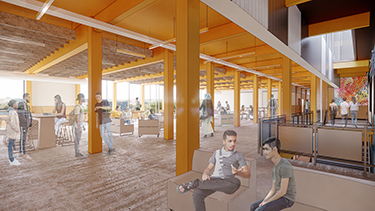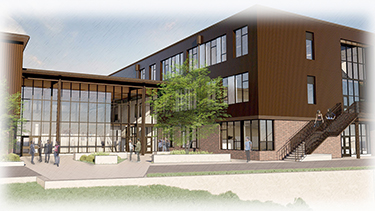|
Subscribe / Renew |
|
|
Contact Us |
|
| ► Subscribe to our Free Weekly Newsletter | |
| home | Welcome, sign in or click here to subscribe. | login |
Construction
| |
 |
October 6, 2022
Here’s how to decrease carbon emissions in schools
Bassetti Architects

Kicinski
|
According to Architecture 2030, buildings produce approximately 40% of total global emissions of carbon dioxide. Most of those emissions are from the annual energy consumption of existing buildings. In response, architects and policymakers have focused for the past several decades on decreasing the energy use of renovations and new buildings.
As a result of those efforts, the operational efficiency of new buildings has greatly improved. As energy use declined, the embodied carbon emissions generated during the manufacture and construction process of new buildings became a much larger portion of the building’s overall footprint. Globally, the embodied carbon of construction equals about 10% of total emissions, or about one quarter to one third of the total emissions attributed to buildings. However, for new buildings, the ratio is lopsided in the other direction. It takes between 20 to 30 years, sometimes longer, for the cumulative operational carbon of energy consumption to equal or exceed the embodied carbon footprint of the initial construction of a new building.
The architecture industry is taking note. Many architects are now focused on finding ways to reduce the embodied carbon of their designs. These strategies can span from the reuse of an existing building to careful material selection. Nonprofits and universities are working to provide knowledge and resources to the industry. At the center of the movement is the Carbon Leadership Forum, a think tank housed at the University of Washington that performs research and develops tools to help the industry reduce embodied carbon.
It’s a rapidly developing area of architectural practice. We’re learning new strategies and refining our approaches with each project. It’s an exciting time. Architects are sharing and collaborating with each other on these solutions. We’re all working towards a global solution to the climate crisis. Bassetti Architects’ practice focuses on K-12 schools. School buildings utilizing innovative methods to reduce embodied carbon emissions present an educational opportunity for students to see examples of buildings, and those responsible for creating them, demonstrating stewardship of the environment.
REUSE
The most impactful decision regarding embodied carbon occurs when deciding to build new or renovate an existing building. School districts often face this decision when seeking to improve older facilities and expand capacity. There are many factors to consider, such as seismic conditions, available land, and the logistics of improving a school that students already attend. When architects can help find solutions that reuse existing structures, it can have a big impact. A report completed in 2011 by the Preservation Green Lab, now the Research and Policy Lab at National Trust for Historic Preservation, looked at a 75-year lifespan of buildings and ran comparative studies across different project types in different regions of the U.S. In all cases, the study found that rehabilitation and retrofit of existing structures resulted in typically 30% fewer carbon emissions over the life of the building when compared to new construction.
Pre-WWII buildings are well suited for energy efficiency upgrades. Designed around minimal mechanical and electrical systems, the buildings were designed to maintain comfort without much energy use. Benson Polytechnic High School in Portland (currently under construction) will restore the historic 1916 main classroom building, the 1927 gym, and the 1930 auditorium. Benson’s modernization will completely reconfigure and update learning spaces with a focus on indoor environmental quality, sustainability, and historic preservation. By applying life cycle assessment (LCA) methodologies and tools, the design team was able to compare the proposed renovation design against the carbon impact of demolition and new construction. The resulting data showed that the replacement building would have a higher initial carbon impact than the proposed design.
USING LESS
Another strategy architects can pursue is to reduce the quantity of materials in buildings. This strategy typically also has cost benefits, which makes it a compelling approach for architects and owners alike. On a recent project, Bassetti worked with the structural engineer to optimize the concrete footings. Using an angle to support the brick veneer instead of concrete allowed the team to reduce the width of the stem wall by 30% around the perimeter.
Concrete has the highest embodied carbon of all material on a project, so any time we can use less concrete, we’re making significant reductions to the overall carbon footprint.
Another place where Bassetti has found an opportunity to reduce material is the building envelope. In recent years the firm has prioritized energy efficiency and increased the insulation in walls and roofs. But what we found is that we hit the point of diminishing returns. Energy use in schools is dominated by the ventilation load in the classrooms. By balancing insulation with high-performing windows, Bassetti works with its mechanical engineers to reduce insulation levels while still meeting energy code and saving energy. The approach results in a minimal increase in energy use but creates a net savings in embodied carbon versus operational carbon. And it reduces construction cost, which is great synergy.
School architects can extend the strategy of reducing materials to the interior finishes, too. Polished concrete floors instead of carpet and resilient flooring are one example. Exposing structure overhead can reduce the material used for ceilings. We want to find the balance between functional needs, like acoustics, with the reduced carbon and cost advantages of doing more with less.
Bassetti tracks the embodied carbon of each project through the multiple phases of design using a tool called Tally. Tally plugs into Revit, the building information modeling software used by many architects, and assigns embodied carbon totals to the material quantities generated by Revit. By tracking each project, Bassetti can compare different embodied carbon strategies and intends to refine its approach with each project. The first step is to track the data.
CARBON MATERIALS
The area of practice experiencing the most development and change is the realm of material selection. More and more manufacturers and suppliers are providing environmental product declarations, known as EPDs, which quantify the life-cycle impacts of a product from extraction to end of use, including embodied carbon. EPDs allow architects to compare products and then make informed decisions about embodied carbon. A new tool developed in association with UW’s Carbon Leadership Forum and operated by the nonprofit Building Transparency is EC3, the Embodied Carbon in Construction Calculator. Architects can use EC3 to compare product EPDs against each other and against industry baselines.
Bassetti is using EC3 when specifying products and in tracking embodied carbon during construction. It’s transformational to have access to that kind of data.
CHOOSE WOOD
The single biggest material choice architects can make is in the building’s structural system. Choose wood. By selecting either a mass timber or light wood framing system instead of steel, architects and structural engineers can make a big reduction in embodied carbon. The design for Mercer Middle School in Seattle, for example, uses a combination of mass timber and light wood framing. The project has an embodied carbon intensity of 22 kilograms CO2 equivalent per square foot, compared to the 35 kgCO2e/sf of a median school. A hybrid steel and wood approach can still result in reductions. At Fairview Middle School in the Central Kitsap School District, the project uses a steel column and floor structure combined with a mass timber roof structure, resulting in an embodied carbon intensity of 28 kgCO2e/sf, a 20% reduction from the median.
It’s important to consider where the wood comes from, however. Specifying responsibly sourced timber ensures those carbon reductions are realized.
SPECIFYING CARBON TARGETS
The information and data now available about the embodied carbon of products allows architects to set carbon targets for the materials they specify. The first material Bassetti has used this approach for is concrete. As mentioned above, concrete represents the single largest source of embodied carbon on most school projects — up to 50% of the total. Working with structural engineers and the baselines developed by the Carbon Leadership Forum, Bassetti set maximum kg of CO2 per cubic yard for each strength of concrete, and allows the supplier to meet the target through their choice of multiple factors, including cement replacements like fly ash, cement type, water ratio, etc. Recent projects have shown surprisingly successful results. On the Multiple Pathways to Graduation building for Portland Public Schools, concrete mix designs achieved 35% to 60% reductions from the CLF baselines.
In conclusion, myriad measures can be taken to reduce carbon emissions of our school buildings, from the reuse of an existing building to careful material selection. We can all play our part by sharing our discoveries as we uncover them.
Kristian Kicinski is an associate principal at Bassetti Architects and the firm’s director of sustainability.
Other Stories:
- Design can influence beyond its borders
- The next great environment for schools
- K-12 alternative delivery is here to stay
- Teamwork creates modern, flexible spaces to learn
- Feasibility and design in early learning education
- Designing a co-location campus
- Centering community for a transformational result
- Building resiliency at University of Washington




